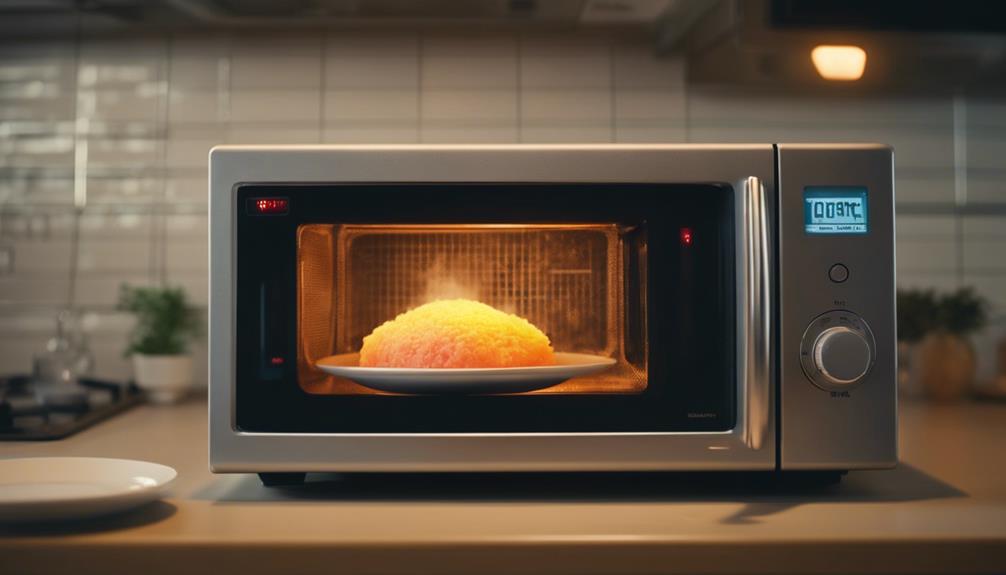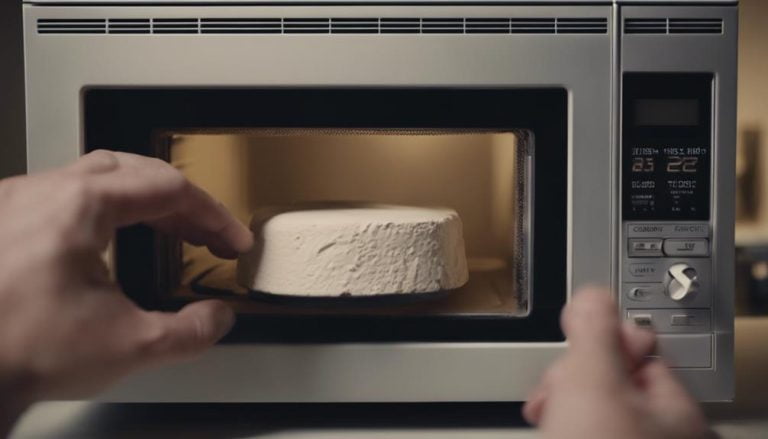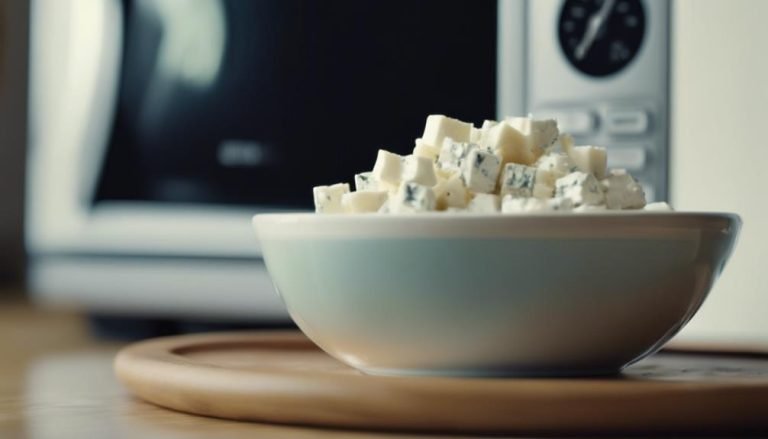Can You Microwave Vinegar
Yes, you can microwave vinegar. However, it’s important to note that microwaving vinegar can produce a strong odor and may cause the liquid to quickly boil over.
It’s best to use a microwave-safe container and cover it with a microwave-safe lid or plastic wrap to prevent any splattering.
Additionally, be cautious when removing the container from the microwave as it may be hot and emit steam.
Overall, microwaving vinegar can be a useful method for cleaning purposes, but it’s important to take necessary precautions to ensure safety and avoid any potential risks.
Key Takeaways
- Dilute vinegar with water before microwaving for safety.
- Microwaving vinegar enhances cleaning and odor removal.
- Follow safety precautions to prevent accidents.
- Utilize microwaved vinegar for cooking and cleaning effectively.
Safety Precautions for Microwaving Vinegar
When microwaving vinegar, it is essential to take safety precautions to prevent accidents and ensure proper handling. Before heating, make sure the microwave-safe bowl used is clean and free of any contaminants.
Dilute the vinegar with water in the safe bowl following recommended guidelines to avoid a violent reaction. By diluting vinegar, you reduce the risk of overheating and potential dangers. Always use a microwave-safe container to prevent any adverse effects on the bowl and microwave.
Prioritize safety by handling the diluted vinegar carefully when placing it in the microwave, ensuring a safe heating process. Following these precautions will help avoid mishaps and ensure a smooth microwaving experience.
Effects of Heating Vinegar in Microwave
Heating vinegar in the microwave can lead to the release of a pungent odor attributed to its acetic acid content. When using vinegar in the microwave, it is essential to be aware of the effects it can have.
Here are some key points to consider:
- Odor Release: Heating vinegar inside of the microwave can result in a strong smell due to its acetic acid content.
- Cleaning Power: Diluted vinegar can be effectively used for cleaning when heated in the microwave.
- Safety Precautions: Always ensure to use microwave-safe containers when heating vinegar to prevent any damage.
- Wiping Down: After using vinegar in the microwave, wipe it clean to remove any residue and odor.
Following these guidelines ensures a safe and effective experience when using vinegar in the microwave.
Alternative Uses for Microwaved Vinegar

Vinegar’s odor-removing properties and grease-cleaning abilities make it a valuable cleaning agent for microwaves. Utilizing vinegar in the microwave can help freshen the appliance and eliminate tough stains effectively.
These cleaning hacks offer a safe and eco-friendly solution for maintaining a clean and odor-free microwave.
Vinegar for Odor Removal
Utilizing the natural cleaning properties of vinegar, one can effectively eliminate stubborn odors and stains in the microwave. Heating vinegar in a bowl inside the microwave can help remove lingering smells and grime. The steam generated from heating the vinegar works to soften dirt and grease, making it easier to wipe clean.
Vinegar, known for its natural cleaning abilities, is a safe and eco-friendly option for freshening up the appliance without the need for harsh chemicals. Combining vinegar with water creates a potent cleaning solution that efficiently tackles odor removal, leaving your microwave smelling fresh and clean.
- The acidic nature of vinegar helps neutralize odors effectively.
- The steam produced by microwaving vinegar penetrates and lifts odors from surfaces.
- Vinegar serves as a natural deodorizer, eliminating strong odors without harsh chemicals.
- Regular use of vinegar can help maintain a fresh-smelling microwave by consistently combating odors.

To ensure a safe and effective process when using vinegar for microwave odor elimination, it is essential to prioritize following recommended safety precautions. When microwaving vinegar, always dilute it with water to prevent a violent reaction. Heating undiluted vinegar for an extended period can lead to potential accidents, so caution is advised. Following recommended guidelines and not overheating vinegar is crucial for safety in the microwave. Be mindful of safety precautions to avoid any mishaps when using vinegar in the microwave. Safety should be a top priority when handling vinegar to ensure a safe and effective cleaning process.
| Safety Precaution | Why it’s Important | How to Implement |
|---|---|---|
| Dilute vinegar | Prevents violent reaction | Mix vinegar with water before microwaving |
| Follow guidelines | Avoid accidents | Adhere to recommended heating times and methods |
| Prioritize safety | Prevent mishaps | Use microwave-safe containers and handle with care |
Vinegar for Grease Cleaning
When tackling grease and grime in your microwave, harnessing the cleaning power of vinegar can effectively cut through stubborn residues. Distilled white vinegar, with its acidic properties (pH around 2.4), serves as a natural cleaner that can break down grease and dried-on food particles. By mixing vinegar with water and heating the solution in the microwave, steam is generated, which helps to soften and loosen the dirt, making it easier to wipe away.
This steam cleaning method is not only efficient but also environmentally friendly, offering a cost-effective way to maintain a clean and odor-free microwave. Regularly using vinegar for microwave cleaning can contribute to the appliance’s longevity and efficiency over time.
| Vinegar for Grease Cleaning |
|---|
| Distilled White Vinegar |
| Steam Cleaning |
| Natural Cleaner |
| Breaks Down Grease |
| Environmentally Friendly |
Can You Microwave Vinegar for Cooking?

Heating vinegar in the microwave can significantly enhance the flavors of dressings and sauces.
When microwaving vinegar for cooking, it is advisable to dilute it with water to prevent accidents or spills.
To avoid overpowering smells, gently heat the vinegar in short bursts.
If any spills occur, clean the microwave door and interior using a damp sponge to wipe away any residue.
After using the vinegar for cooking, promptly refrigerate any unused dressings to maintain freshness and ensure safety.
Frequently Asked Questions
Can Microwaving Vinegar Cause Any Damage to the Microwave Itself?
Microwaving vinegar poses risks due to its potential for violent reactions and damage to the microwave. Diluting vinegar with water before heating is essential to prevent harm. Following safety precautions and cleaning tips ensures proper microwave maintenance.
Is It Safe to Microwave Vinegar in a Plastic Container?
In the context of vinegar reactions, it is advisable to exercise caution when microwaving vinegar in a plastic container. Prioritize plastic safety by choosing microwave-safe containers to prevent potential hazards and ensure compliance with microwave precautions for optimal safety.
Can Microwaving Vinegar Cause Any Harmful Fumes to Be Released?
When heating vinegar in the microwave, precautions must be taken to prevent potential reactions. Diluting vinegar with water is recommended to minimize odor concerns. Proper ventilation and adherence to recommended heating times ensure microwave safety when working with vinegar.
Can Microwaving Vinegar Affect the Taste or Quality of Food Cooked in the Microwave Afterwards?
Microwaving vinegar for cleaning purposes may create a temporary odor, but it typically does not alter the taste or quality of subsequent microwave-cooked foods. Proper ventilation and cleaning post-use ensure vinegar preservation and minimal flavor impact.
Are There Any Specific Types of Vinegar That Should Not Be Microwaved?
Certain vinegar types, like balsamic and flavored varieties, may not be suitable for microwaving due to potential flavor alterations or damage. Stick to pure white vinegar or apple cider vinegar for recipes and cleaning benefits.
Conclusion: Microwaving Vinegar Dos and Don’ts
In considering the proper handling of vinegar in the microwave, it is crucial to adhere to safety guidelines and best practices. When microwaving vinegar, follow these dos and don’ts:
- Always dilute vinegar with water before microwaving to prevent a violent reaction.
- Use a microwave-safe bowl or cup of water alongside the vinegar to avoid overheating.
- Open the microwave door carefully after heating to allow steam to escape safely.
- Remove the bowl or cup of water and vinegar cautiously to prevent burns or spills.






